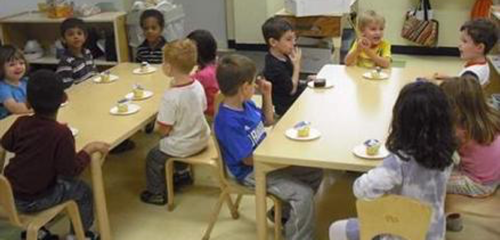Lesson 10: Meal Observation, Lesson Plan and Implementation
Attention

Learning Outcomes
Upon completion of this lesson's material, students will be able
- Complete the use of the running record observation technique
- Use the running record to inform lesson planning
- Implement lesson plan that was created based on running record findings
- Reflect up on observation as a technique to gather data and improve practice
- Explain the importance of meal time in early care settings
Teaching
Mealtimes in early care settings are often hectic and stressful. It is that time of day when kids start having meltdowns and recess, naptime or pick up just can’t come soon enough. HOWEVER, it is also that time of day to connect. It is time to re-cap what happened throughout the day and bond with the children. You can also get great observations through conversations and just simply watching how they self-serve and interact with their peers. Meal times do not have to be stressful if you make them intentional and positive.
Most programs provide family style meals for their children. Essentially this means that all of the children sit together, self-serve and have rich discussions while eating. In the infant, toddler sites, you may even see the infants brought up to the tables in their seats so that they are a part of the meal also! Read the information on meal times and make notes about what you hope to see when you do your running record.
Click HERE to download a PDF titled "Impact of Teachers and Famlies on Young Childrens' Eating Behaviors"
Click HERE to download a PDF titled "Family Style Meals"
Running records are a similar tool to the anecdotal record but are more of a narrative observation. To do a running record you will simply write down EVERYTHING you see during a certain time period. Most running records are around 20-30 minutes. During these minutes the recorder is extremely objective while they write down the facts of what they see. Think of it like a video camera on paper. You want the reader to see everything that you saw…..but in the writing instead of on the screen.
Click HERE to view some Running Record examples.
A few advantages of using a running record instead of an anecdotal are that it is richer in detail and captures an entire section of the day. The teacher can then go back and look at the running record and be objective about how to make a plan and move forward for the next time. Unfortunately, the person doing the record must be able to keep themselves apart from the children so that they are not distracted and can capture everything.
See the examples of running records to aid you in your observation. Please note that these examples are not long enough. It is unlikely that they capture an entire 20-30 minutes. For this exercise, your running record should be as long as the meal time you observe.
Assessment
Lesson 10 Assignment
You will be using the Anecdotal Form and the Lesson Plan Form for this assignment
Observation
- Decide why you are observing meal time (aside from its required in this course). What is the objective?
- What are you hoping to gain from the observation?
- Will you be observing one child for all of mealtime or ALL children during meal time?
- Choose a time that best works for you and the site to observe a meal
- Use the ANECDOTAL FORM provided to complete the observation
Planning
- In the comments section of the ANECDOTAL FORM write your analysis or interpretation of the observations
- What is the observation telling you? How does this relate to your lesson plan?
- Create a lesson plan using the LESSON PLAN FORM (do only the first two sections).
- Assure this is related to your observation and observation objective.
- Review the LESSON PLAN RUBRIC as you put your Lesson Plan together.
Implementation
- Implement your activity
- Complete self-assessment portion of the planning form. The third section in the LESSON PLAN FORM
Possible Class Discussion
Go back to the seven strategies for connecting in your Powerful Interactions book (page 32-33). What strategies did you notice the staff using in your observation. Be specific with examples.